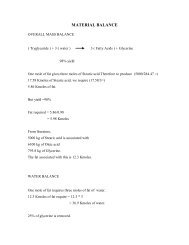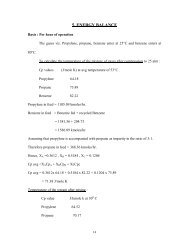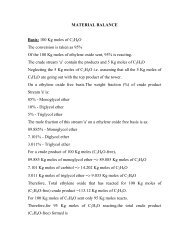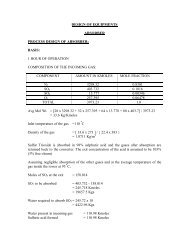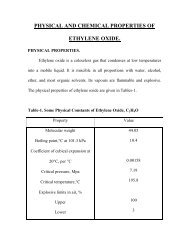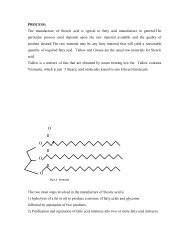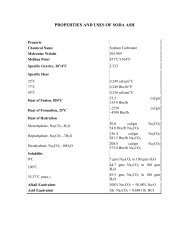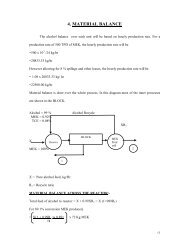MANUFACTURING METHODS:- As described above, sulfuric acid is ...
MANUFACTURING METHODS:- As described above, sulfuric acid is ...
MANUFACTURING METHODS:- As described above, sulfuric acid is ...
You also want an ePaper? Increase the reach of your titles
YUMPU automatically turns print PDFs into web optimized ePapers that Google loves.
<strong>MANUFACTURING</strong> <strong>METHODS</strong>:-<strong>As</strong> <strong>described</strong> <strong>above</strong>, <strong>sulfuric</strong> <strong>acid</strong> <strong>is</strong> an important raw material for phosphate fertilizerproduction and to a much lesser extent for nitrogen and potassium fertilizers. Worldproduction of <strong>sulfuric</strong> <strong>acid</strong> was about 121 million tons in 1977 and about half of th<strong>is</strong>production was used in the fertilizer production.About 58% of the worlds production was based on elemental Sulfur, 25% on Pyrite and17% on other sources. Of the other sources, the principal one was the by-product <strong>sulfuric</strong><strong>acid</strong> recovered from smelting operations.In general terms, the <strong>sulfuric</strong> <strong>acid</strong> <strong>is</strong> produced by catalytic oxidation of sulfur dioxide tosulfur trioxide, which <strong>is</strong> subsequently absorbed in water to form <strong>sulfuric</strong> <strong>acid</strong>. In practicethe sulfur trioxide <strong>is</strong> absorbed in <strong>sulfuric</strong> <strong>acid</strong> which <strong>is</strong> kept at a controlled concentration(usually 98%) by the addition of water.There are no major variations of commercial interests on th<strong>is</strong> mentioned chem<strong>is</strong>try. Thereare alternatives as to source of Sulfur dioxide and method of conversion to sulfurtrioxide. The two most common methods for the conversion of sulfur dioxide to <strong>sulfuric</strong><strong>acid</strong> areLead Chamber Process:1. Lead Chamber Process:2. Contact ProcessTh<strong>is</strong> <strong>is</strong> an old process and was introduced in Europe in near the middle of 18 th century.Th<strong>is</strong> method uses nitrogen oxides as oxygen carrying catalysts for the conversion ofsulfur dioxide to sulfur trioxide. The reactions which produce the sulfur trioxide and<strong>sulfuric</strong> <strong>acid</strong> take place within the huge lead chambers or in packed towers which may besubstituted for the chambers. Chambers process produced <strong>acid</strong> of concentration less than80 %.The major d<strong>is</strong>advantage includes the limitations in throughput, quality andconcentration of the <strong>acid</strong> produced. All known new plants uses the Contact processalthough some older Chamber process plants may still be in use.Contact Process:In the contact processes, the sulfur dioxide <strong>is</strong> converted to sulfur trioxide by the use ofmetal oxide catalyst. Platinum was once widely used as catalyst but because of it’sexcessive first cost and susceptibility to po<strong>is</strong>oning, it has been largely replaced byvanadium oxide. The vanadium pentaoxide <strong>is</strong> d<strong>is</strong>persed on a porous carrier in a pelletform. The characterstics of the catalyst which can be used are mentioned as follows:1. Porous carrier having large surface area, controlled pore size and res<strong>is</strong>tance toprocess gases at high temperature; in pellet form if used in fixed bed andpowdered form if used for fluidized bed. Ex- Alumina, silica gel, zeolites.
2. Active catalytic agent:Vanadium pentaoxide in th<strong>is</strong> case. Preparations are generally kept secret for thecompetitive reasons but they usually cons<strong>is</strong>t of adding water soluble compoundsto gels or porous substrates and firing at temperature below the sintering point.3. Promoter:Alkali and/or metallic compounds added in trace amounts to enhance the activityof the catalytic agent.Advantages of the V 2 O 5 catalyst1. Relatively immune to po<strong>is</strong>ons.2. Low initial investment and only 5% replacement per year.D<strong>is</strong>advantages of V 2 O 5 catalyst1. Must use dilute SO 2 input (7-10%).2. <strong>As</strong> a catalyst it <strong>is</strong> less active and requires high oxygen or sulfur dioxide to giveeconomic conversions3. Requires larger converters and thus higher initial investment.Now the SO 3 gas <strong>is</strong> passed to an absorption tower where it <strong>is</strong> absorbed in recirculatingconcentrated <strong>acid</strong>. There are many variations in the contact process depending upon thetypes of raw materials available and other considerations; also a number of engineeringvariations are in use by many different design/construction firms offering services in th<strong>is</strong>field.Main d<strong>is</strong>advantages of the contact process are that concentrated <strong>acid</strong> (98%) of high puritycan be produced directly and that compact plants of quite high capacity have now becomerather common place.THE PRODUCTION OF SULFURIC ACID BY CONTACT PROCESS:RAW MATERIALS:One of the early raw materials for the <strong>sulfuric</strong> <strong>acid</strong> was sulfate of iron or vitriol. Byheating the solid sulfate and condensing the fume an oil of vitriol resulted. The rectifiedoil of vitriol (ROV) <strong>is</strong> concentrated <strong>acid</strong> and the brown oil (BOV) <strong>is</strong> about 77% SulfuricAcid. The raw materials for <strong>sulfuric</strong> <strong>acid</strong> manufacture are chiefly Sulfur, Pyrites, Spentoxide, anhydrite and gases from the smelting of metalliferous ores, from the purificationof natural gas and from refining operations.
CHEMISTRY OF SULFURIC ACID PRODUCTION:The equations governing the production of <strong>sulfuric</strong> <strong>acid</strong> are:S + O 2 SO 2 û+ -70 KCal(solid) (gas)SO 2 + 1 / 2 O 2 SO 3 û+ -23.50 KCalSO 3 + H 2 O H 2 SO 4 û+ -32 KcalThe first reaction expressing the combustion of sulfur <strong>is</strong> strongly exothermic; sulfur onburning gives about one third of the heat of combustion of coal, and th<strong>is</strong> heat ra<strong>is</strong>es thetemperature of combustion gases roughly in accordance with the graph as shownTh<strong>is</strong> heat <strong>is</strong> high in temperature and there <strong>is</strong> plenty of it, consequently it <strong>is</strong> worth utilizingand the hot gases are led across pipes through which the water passes. The water <strong>is</strong>heated, steam <strong>is</strong> ra<strong>is</strong>ed and the gases are cooled. Th<strong>is</strong> <strong>is</strong> the arrangement in the water tubeboiler. In the fire tube boiler the hot gases pass through the tubes which are surroundedwith water.The second equation <strong>is</strong> also exothermic and it’s apparent that the equation gives adecrease in volume, three volumes become two volumes and th<strong>is</strong> reaction would be aidedby pressure. High conversions are however, obtainable with catalysts at 400 to 500 Û Cwith a small excess of oxygen and the use of pressure.The third equation represents the absorption of sulfur trioxide to form <strong>sulfuric</strong> <strong>acid</strong>. It <strong>is</strong>exothermic and the absorbing <strong>sulfuric</strong> <strong>acid</strong> has to be cooled continuously; the heat <strong>is</strong>available at a relatively low temperature and <strong>is</strong> not worth recovering. Sulfuric <strong>acid</strong> <strong>is</strong> usedfor the absorption of sulfur trioxide as it has been found in practice that sulfur trioxideand water form a m<strong>is</strong>t, which <strong>is</strong> difficult to separate from the gas and that under theseconditions the absorption, <strong>is</strong> not complete. The strength of the <strong>acid</strong> <strong>is</strong> best about 98%.
SULFUR HANDLING AND STORAGE:Sulfur used for the production of <strong>sulfuric</strong> <strong>acid</strong> <strong>is</strong> practiced to handle as solid in bulk, fromship to wagon and from wagon to cool off and solidify; it can then be broken up andshovelled into wagons for d<strong>is</strong>posal. It cons<strong>is</strong>ts of carbonaceous matter and inorganic ash.Although commercial sulfur <strong>is</strong> over 99% sulfur, the impurities present as dust in the plantgases tend to be filtered out by the catalyst and a blanket or layer of hardened dust on thecatalyst detracts from the efficiency of conversion. In consequence some manufacturersfilter the molten sulfur through leaf filters to remove some of the impurities and so obtaina longer period before the plant has to be shut down for cleaning away the dust andsieving the top layers of the catalyst from it. However, the filter leaves have to beremoved for the replacement of the filtering medium and for the removal of theaccumulated sludge, and these unpleasant operations, together with the installation costof the equipment, have to be weighed against the benefits of having slightly less dustygases.SULFUR BURNING:There are several types of burners for sulfur. One <strong>is</strong> revolving cylinder containing pool ofmolten sulfur which <strong>is</strong> combusted by the passage of air over its surface. Another type <strong>is</strong> abrick lined vertical cylindrical vessel in which <strong>is</strong> erected a pile of fire brick in the form ofa pyramid, and on to th<strong>is</strong> structure molten sulfur <strong>is</strong> pumped to be met by a stream of cocurrentdry air for its combustion. A third variety <strong>is</strong> in the form of a burner similar to anoil burner.The quantity of air <strong>is</strong> regulated to give between 8 to 10% SO 2 .In the starting up the plant with a vertical burner the fire-brick <strong>is</strong> first heated by theburning of a fuel gas. The gas, when a sufficiently high temperature has been reached <strong>is</strong>cut off and the liquid sulfur <strong>is</strong> pumped over the brick-work. A measured amount of air <strong>is</strong>passed down the burner and the sulfur burns to sulfur dioxide providing sufficient heat innormal operation to ra<strong>is</strong>e the temperature of the gases to some 810-900 Û C. If the aircontains 21% oxygen and sulfur <strong>is</strong> burned to give 10% sulfur dioxide gas, then 11%oxygen and 79% nitrogen will form the residual gases. Some excess oxygen <strong>is</strong> necessaryover and <strong>above</strong> that required to combine with the sulfur and the sulfur dioxide. Out of the11% oxygen, 5% will be required to combine with the dioxide to form the trioxideleaving an excess of 6%. Th<strong>is</strong> <strong>is</strong> adequate but if attempts were made to have a 14% sulfurdioxide gas then 14% from the 21% oxygen would be taken up in forming sulfur dioxideand another 7% would be required to convert the dioxide to trioxide. Th<strong>is</strong> would leave noexcess oxygen and an excess has shown to be essential for a good conversion of thedioxide.When sulfur burns, the gases r<strong>is</strong>e to a temperature depending on the dioxideconcentration; with 8% sulfur dioxide the temperature <strong>is</strong> about 750 Û C. In the diagram, thegas temperatures are plotted against the dioxide concentrations. To withstand these
The temperature of the exit gases <strong>is</strong> controlled by a by-pass on the waste heat boiler. Theamount of heat evolved <strong>is</strong> dependent upon the quantity of sulfur and the temperature onthe proportion of sulfur dioxide in the gases. The higher the temperature, the higher <strong>is</strong> theproportion of heat which <strong>is</strong> to be removed. It <strong>is</strong> best to gauge th<strong>is</strong> so that the waste eatboiler by-pass in normal operation <strong>is</strong> almost shut.The waste heat boiler design takes into consideration the following factors. The area ofthe tubes must be adequate to take the requ<strong>is</strong>ite amount of heat from the gases. Th<strong>is</strong> <strong>is</strong>dependent upon the amount of heat transferred per unit of tube area, which itself <strong>is</strong>dependent upon the velocity of gases over the tubes and the temperature differencebetween the gases and the boiler waterGAS DRYING:It has been found in practice that if mo<strong>is</strong>ture <strong>is</strong> present in the gases before conversion, asulfur trioxide m<strong>is</strong>t will form after the converters, which <strong>is</strong> extremely difficult to absorbin the <strong>acid</strong> absorbers. There are several theories to account for th<strong>is</strong>. It may be that thesulfur trioxide particles are surrounded by a film of <strong>acid</strong> and the aggregates aresufficiently small to pass through the absorbers and out into the atmosphere, giving r<strong>is</strong>eto inefficient absorption and causing a local nu<strong>is</strong>ance. There m<strong>is</strong>ts can be destructive tovegetation, damaging to buildings and extremely unpleasant to life in the vicinity. It <strong>is</strong>therefore essential to use dry air for sulfur burning or install special plant for absorbingthe m<strong>is</strong>t, which <strong>is</strong> a difficult proposition.Air <strong>is</strong> dried in a drying tower which uses strong <strong>sulfuric</strong> <strong>acid</strong> for th<strong>is</strong> purpose. The towercons<strong>is</strong>ts of a mild steel vertical cylinder lined with <strong>acid</strong>-res<strong>is</strong>ting brick and packed withceramic rings. The <strong>acid</strong> <strong>is</strong> d<strong>is</strong>tributed down the tower and air <strong>is</strong> blown upwards countercurrentto the <strong>acid</strong> by a blower which also serves to give the air sufficient for it to passthrough the whole of the <strong>sulfuric</strong> <strong>acid</strong> plant to atmosphere after the absorbers.The vapor pressure of water <strong>above</strong> <strong>acid</strong>s of high concentrations at ordinary temperaturescan be extremely low and consequently under the right conditions (95-98% H 2 SO 4 at35 Û C or less) the <strong>acid</strong> removes nearly all the water vapor in the air that <strong>is</strong> down to30mg/m 3 .The tower has to be of a sufficient diameter not to require a significant pressure drop forthe gases to pass through it and to have an adequate surface area of packing for theabsorption of water from the air to take place in the time which the gases take to passthrough the tower volume. Consequently the gas velocity up the tower must be small, andth<strong>is</strong> will determine the minimum diameter of the tower. The amount of <strong>acid</strong> used in thetower has to be significant to wet the surface of the packing without flooding and not tobecome so dilute that its vapor pressure becomes appreciable. The amount of water in airat a given temperature and relative humidity <strong>is</strong> known and hence the minimum quantityof 98% <strong>acid</strong> on the drying tower can be calculated.
It <strong>is</strong> common practice to use <strong>acid</strong> from the absorption section on the drying tower; theheat of dilution <strong>is</strong> then removed on the absorption coolers but coolers are sometimesprovided on the drying section with a bleed-off to the absorption circulation system.GAS FILTRATION:The gas from the burners after passage through the waste heat boiler contains ash fromthe sulfur and some scale from the waste heat boiler and gas lines. These solid impuritiesare best removed before the gases enter the converter; otherw<strong>is</strong>e the dust accumulates onthe layers of catalyst and causes channeling through the catalyst layers, irregular contactand pressure drop.The filter cons<strong>is</strong>ts simply of the wide diameter vessel filled with the filtering mediumwhich <strong>is</strong> commonly the lumps of quartz. The vessel <strong>is</strong> of squat cylindrical shape in mildsteel. The gases pass downwards to ass<strong>is</strong>t in the removal of the solids at a velocity which<strong>is</strong> slow because of the wide diameter of the vessel. When the filter <strong>is</strong> first put into service,the pressure drop <strong>is</strong> several m atmospheres, but when it <strong>is</strong> ready for opening andcleaning, th<strong>is</strong> pressure drop r<strong>is</strong>es to some 100m atmosphere. The interval betweenremovals of dust depends on the ash content of the sulfur; a filter usually lasts three to sixmonths and th<strong>is</strong> period would be extended if the molten sulfur were also filtered beforeburning.In many cases the gas filtration unit may not be present and thus th<strong>is</strong> step may be treatedas the auxiliary unit, depending upon the requirement. In the flow sheet given, the gasfiltration unit <strong>is</strong> not shown.CONVERSION:The converter <strong>is</strong> a reactor and its objective <strong>is</strong> to combine the sulfur dioxide with theresidual oxygen in the gases to form sulfur trioxide. The conversion <strong>is</strong> aided by a catalystand the more sensitive the catalyst the lower the temperature at which the conversiontakes place and more favorable the equilibrium but in general sensitive catalyst are morereadily po<strong>is</strong>oned. In practice it <strong>is</strong> necessary to have a catalyst which <strong>is</strong> sufficiently robustto res<strong>is</strong>t po<strong>is</strong>oning but <strong>is</strong> active enough to give good conversion at about 400 Û C. Theconverter cons<strong>is</strong>ts of a tall cylindrical vessel of sufficient diameter (generally 3.5 to5.5m) to give a low gas velocity, inside which there are three or four trays for quantitiesof catalyst. Between the catalyst sections there are devices for cooling the gases to keepthe temperature entering the later catalyst sections in the region of 405 to 440 Û C. The firstcatalyst pass contain relatively little catalyst because the reaction <strong>is</strong> rapid and thetemperature r<strong>is</strong>es sharply; the second a little more, and the last stages most of the catalyst,where both the sulfur dioxide and oxygen are less concentrated.After the passage through the first catalyst tray when the gas temperature has r<strong>is</strong>en fromabout 410 Û C to over 600 Û C, the gases pass into an external waste heat boiler to ra<strong>is</strong>e steamand bring the gas temperature down to 430 Û C and at th<strong>is</strong> temperature the gases enter the
second catalyst tray. On passing through the catalyst the temperature again r<strong>is</strong>es but th<strong>is</strong>time not so much, and after the second tray sufficient heat can be removed bysuperheating the steam ra<strong>is</strong>ed in the waste heat boilers. The super heater tubes are ledfrom the boiler into a space underneath the catalyst bed in the path of the gases. Thetemperature <strong>is</strong> again brought down to about 430 Û C and after the third pass the gases aresimilarly cooled. In the final section, which contains most of the catalyst, the temperaturer<strong>is</strong>e <strong>is</strong> small as the reaction has been brought near the equilibrium value in the previouspasses and only relatively small amounts of sulfur dioxide and oxygen remain to react.After leaving the catalyst the gases are at 400 to 450 Û C; they are passed through theeconomizer where the temperature <strong>is</strong> reduced to a lower value. The gases then passthrough an air cooler to the absorbers.The catalyst cons<strong>is</strong>ts of vanadium in the form of small pellets or cylinders. The totalvolume <strong>is</strong> arranged to give the time of contact necessary for the reaction to take place.The speed of the reaction depends on the activity of the catalyst. A conversion of sulfurdioxide to trioxide of between 98 and 99 % <strong>is</strong> achieved.The equilibrium <strong>is</strong> given byK P =(P SO3 )(P SO2 ) (P O2 ) ½(P SO2 ) (P O2 ) ½ should be as high as practicable to give a good value for (P SO3 ). If there <strong>is</strong>excess of oxygen (P O2 ) ½ will increase in value but too great an excess will dimin<strong>is</strong>h(P SO2 ) initially. On some converters, air <strong>is</strong> introduced between the converter stages whichacts as a cooling medium and provides the additional excess of oxygen.A graph showing K P plotted against temperature <strong>is</strong> given in the figure below:Below 400 Û C the reaction <strong>is</strong> very slow but <strong>above</strong> 630 Û C the reaction <strong>is</strong> fast but theequilibrium <strong>is</strong> becoming unfavorable, the reaction goes more quickly the higher thetemperature, but the equilibrium becomes unfavorable. The aim in running the converter
<strong>is</strong> to maintain a pattern of temperature which experience has shown will give theoptimum conversion. These temperatures depend on the catalyst activity, gas strengthsand other factors. Figures for four stage converter for temperatures and conversion aregiven as follows:The running of the converter cons<strong>is</strong>ts in close observance of temperatures, the pressuredrops and the sulfur dioxide conversion. The temperature r<strong>is</strong>e across the catalyst <strong>is</strong> themeasure of the amount of reaction taking place. Pressure drops across the bed of catalyst,if they are abnormally high, indicate a partial blockage and channeling through thecatalyst, which would be accompanied by a small temperature r<strong>is</strong>e. A high pressure dropacross the first pass may necessitate shutting down the plant and screening the top layerof the catalyst which has possibly become choked with dust.ABSORPTION:The gas leaving the reactor <strong>is</strong> cooled further in a heat exchanger as mentioned <strong>above</strong> andbefore entering the absorption tower where the Sulfur trioxide <strong>is</strong> absorbed in arecirculated stream of concentrated <strong>sulfuric</strong> <strong>acid</strong>. The <strong>sulfuric</strong> <strong>acid</strong> <strong>is</strong> maintained atdesired concentration (usually 98% H 2 SO 4 ) by the addition of water and its temperature<strong>is</strong> controlled in the desired range of 70 to 90 Û C measured at the tower inlet by cooling therecirculated <strong>acid</strong>.Some of the <strong>acid</strong> goes to the air drying tower mentioned previously where the mo<strong>is</strong>turefrom the incoming air supplies some of the water needed in the reaction. Since, the heatreleased in th<strong>is</strong> step <strong>is</strong> at a low temperature level, little use can be made of it.In the <strong>above</strong> mentioned Single Absorption process, the recovery of the sulfur as <strong>sulfuric</strong><strong>acid</strong> <strong>is</strong> 97-98% and the remainder <strong>is</strong> lost to the atmosphere as Sulfur dioxide. In manycountries, the d<strong>is</strong>charge of th<strong>is</strong> amount of Sulfur dioxide to the atmosphere <strong>is</strong>environmentally unacceptable. Therefore most of the plants use a Double Contact DoubleAbsorption Process (DCDA)The gas after passing through three catalyst bed goes to the first absorption tower wherethe Sulfur trioxide <strong>is</strong> removed. The gas <strong>is</strong> then reheated to about 420 Û C, passed throughthe fourth catalyst bed, then cooled and sent to a second absorption tower.In the reaction2SO 2 + O 2 2SO 3
emoval of the reaction product sulfur trioxide facilitates more efficient conversion in thelast catalyst bed. The DCDA process reduces the sulfur dioxide loss to less than 2Kg ofsulfur dioxide/ ton of the <strong>sulfuric</strong> <strong>acid</strong>. High efficiency m<strong>is</strong>t eliminators are also requiredto limit the loss of <strong>sulfuric</strong> <strong>acid</strong> m<strong>is</strong>t to less than 0.05Kg/ton of <strong>sulfuric</strong> <strong>acid</strong>.Thus the recovery in a DCDA plant should atleast be 99.8%.THE TAIL GAS:The gas from the absorption section contains about 0.15 % sulfur dioxide which oxidizesin part to sulfur trioxide and forms m<strong>is</strong>t. At th<strong>is</strong> concentration, corresponding to aconversion efficiency of over 98%, the effluent <strong>is</strong> tolerable and no further treatment ofgas <strong>is</strong> required. In exceptional cases where the oxygen content <strong>is</strong> low or for other reasonswhere the conversion <strong>is</strong> down, the gases can be scrubbed with ammonia liquor and thentreated by electrostatic precipitator.STORAGE:The last part of the <strong>sulfuric</strong> <strong>acid</strong> plant <strong>is</strong> the storage and the pumping system. The tanksare large flat cylinders which are sometimes of more than 1000 tons capacity. Thepumping of <strong>acid</strong> <strong>is</strong> commonly done by the centrifugal pumps, the submerged glandlesstype on smaller tanks where the shaft can be less than about 10ft in length. The absenceof gland leaks makes for a neat and clean pumping section. The storage installationshould be calculated to maintain continuity of supply, if th<strong>is</strong> <strong>is</strong> required, during theshutdowns of the <strong>acid</strong> plant and to cater for peak demands.DEVELOPMENTS:The use of the DCDA system adds 10 to 15% to the cost of the plant in compar<strong>is</strong>on withthe older Single Absorption Process. It also uses more energy and produces less steam orother recoverable energy. An alternative which <strong>is</strong> less expensive <strong>is</strong> to recover the sulfurdioxide from the single absorption plant by ammonia scrubbing. Scrubbing the gas withthe ammonia solution produces an ammonium sulfite solution which <strong>is</strong> then <strong>acid</strong>ulatedwith <strong>sulfuric</strong> <strong>acid</strong>. The liberated sulfur dioxide <strong>is</strong> returned to <strong>sulfuric</strong> <strong>acid</strong> plant and aconcentrated ammonium sulfate solution remains which may find use in a fertilizerindustry.Operation of the <strong>sulfuric</strong> <strong>acid</strong> plant has some advantages,1. The equipment <strong>is</strong> smaller and less expensive2. Less Catalyst <strong>is</strong> required.3. Equilibrium condition and reaction rates are more favorable in the conversion andabsorption steps.
The solubility of sulfur dioxide in <strong>sulfuric</strong> <strong>acid</strong> increases with the increase in pressure andwith the decrease in temperature. In a conventional plant operating at 1 atm and with an<strong>acid</strong> temperature 110 Û C, the solubility of sulfur dioxide in <strong>sulfuric</strong> <strong>acid</strong> <strong>is</strong> only 8ppm.However, increasing the pressure to 8 atm and lowering the temperature to 49 Û C, thesulfur dioxide solubility <strong>is</strong> increased to 190ppm.Under these condition a substantialamount of sulfur dioxide can be transferred in the <strong>acid</strong> stream to the air drying tower andthen to the incoming air stream. Many authors have pointed out that there <strong>is</strong> notheoretical limit to the amount of sulfur dioxide that can be recycled or recovered; itdepends on the rate of re circulation of the <strong>acid</strong> between the absorber and the air dryingtowers.




